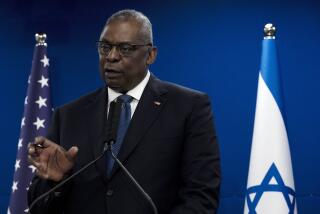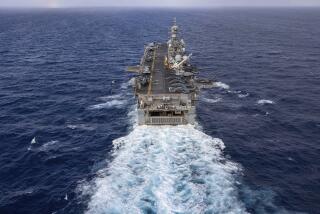Kuwait’s Seacoast May Be a Chink in Hussein’s Armor : Military: A powerful U.S. amphibious assault force has been assembled. Iraqis lack experience in shoreline defense.
- Share via
DHAHRAN, Saudi Arabia — Iraq’s decision to seize all of Kuwait rather than just a smaller, more defendable portion has left its forces vulnerable to an assault from the sea and provided an attractive opening for U.S. forces should war come, a U.S. military official said Friday.
Rear Adm. John LaPlante, commander of a U.S. amphibious task force in the Gulf of Oman, said Iraq’s full-scale invasion has confronted it with the need to erect coastal defenses along the nation’s long shoreline.
It is the first time the Iraqi military has faced such a task, and “I don’t think they’re very good at it,” he said.
Iraq’s move to seize the entire nation Aug. 2 surprised many U.S. analysts, who expected any military thrust to take just the northern part of the country, giving Iraq some desired sea access, lessening hostile world reaction and providing a more secure military position.
Now, a seaborne assault is considered a strong possible option if the United States moves to dislodge Iraq by force.
“You have the entire spectrum of amphibious assault capacity represented in this task force,” LaPlante declared from the bridge of the Nassau in an interview with the first group of reporters to visit the task force since it arrived in the region.
The Norfolk, Va.-based group, which carries a potential landing force of 10,000 Marines, is the largest such U.S. unit assembled for combat in about 40 years, its commanders said.
The 18-ship unit could land Marines by landing craft, small boat or helicopter under the cover of an aerial assault from Harrier jump-jet fighters and a barrage from naval guns offshore.
“You have a very potent package if you need to use it,” said Maj. Gen. Henry W. Jenkins, commander of the 4th Marine Expeditionary Brigade, the Marine element of the 17,000-member task force.
Iraq reportedly has moved batteries of Silkworm missiles to Kuwait to defend against the U.S. threat from the sea. But in interviews on board the 833-foot Nassau, the commanders discounted Iraqi President Saddam Hussein’s capacity to build an adequate barrier and expressed confidence that the unit’s constant mobility would make it difficult for Iraq to counter.
“They don’t really know where we are, so we have the element of surprise,” Jenkins said. “We can pick and choose, depending on what the (commander in chief) wants to do, an area and a time of our own choosing.”
Until its forceful annexation of Kuwait, Iraq had only a small outlet to the sea, and it has virtually no navy. The invasion gave it control of hundreds of miles of Kuwaiti coastline and a number of little-defended islands near the shore.
There has been considerable speculation among analysts about the possibility of a U.S. amphibious assault as an alternative to a punishing land campaign in a bid to drive Iraqi forces from Kuwait.
The comments by the Navy and Marine commanders Friday represented the most extensive public discussion of the subject by senior military officials and advanced the theory that Iraq could be highly vulnerable to an attack from the sea.
Commanders said that the amphibious task force includes 13 ships from the Navy’s Atlantic armada and five from the Pacific.
The task force is part of an American fleet in the gulf, the Arabian Sea and the eastern Mediterranean that now totals about 30 ships, including the aircraft carriers Independence, Saratoga and John F. Kennedy and the battleship Wisconsin, which carries 32 Tomahawk cruise missiles. Seven other U.S. ships are expected in the Mediterranean.
The visit to the Nassau was limited to a single television crew and journalists from Navy publications, but a videotape of the session, recorded by the Navy Broadcasting Service, was made available to reporters in Dhahran.
Below deck, rows of M-60 tanks were aligned with their guns pointing aft through the open stern of the vessel as it steamed near a top speed of 24 knots.
Marines on board said that they had spent much of their time working to ensure that their aging M-60 tanks would be ready for use in combat, if necessary.
“It’s just like anything else,” said Cpl. Jerry Case, the driver in a four-man M-60 crew. “You take care of it, and it will take care of you.”
On the flight deck, Marine aviators demonstrated the capabilities of their Harrier fighters, known as jump jets for their ability to take off on a very short runway and to land almost like a helicopter.
Commanders said that the Harriers, used by British forces in the Falkland Islands conflict but never by American forces in combat, would provide an amphibious landing with the kind of overhead firepower that previously required the help of an aircraft carrier.
Maj. William F. O’Hara, a Harrier pilot, noted that the plane could be “very useful in this scenario” because of its ability to land on unimproved fields, presumably after an amphibious assault was completed.
Asked how the planes might be most likely to be used against Iraq, however, O’Hara only smiled wryly and said: “I wish I really knew.”
AN AMPHIBIOUS ASSAULT
Iraq must defend many miles of Iraqi-Kuwati coastline, extending from the mouth of the Shatt al Arab waterway to the Saudi frontier.
The U.S. amphibious task force now on station in the Persian Gulf region has a potential landing force of 10,000 Marines with M-60 tanks. The force could put Marines ashore by landing craft, small boats and helicopters under cover of aerial assault from Harrier jump-jet fighters and a barrage from naval guns.
More to Read
Sign up for Essential California
The most important California stories and recommendations in your inbox every morning.
You may occasionally receive promotional content from the Los Angeles Times.













